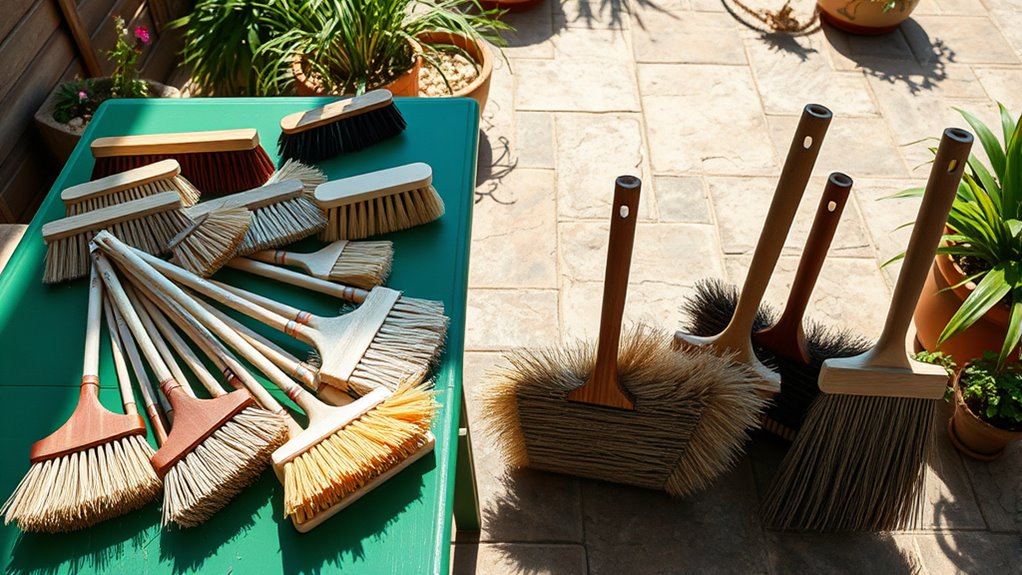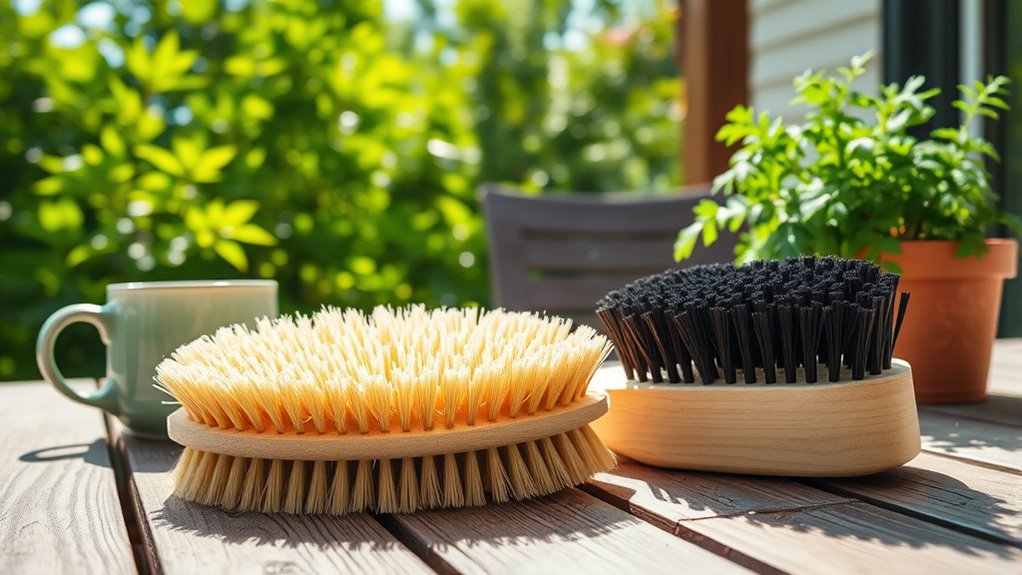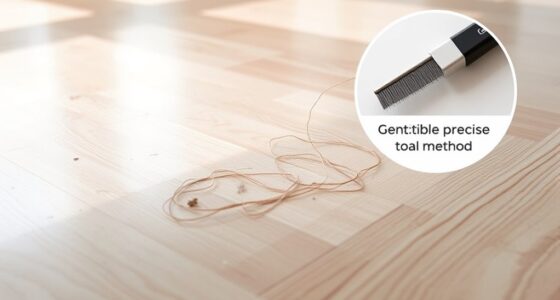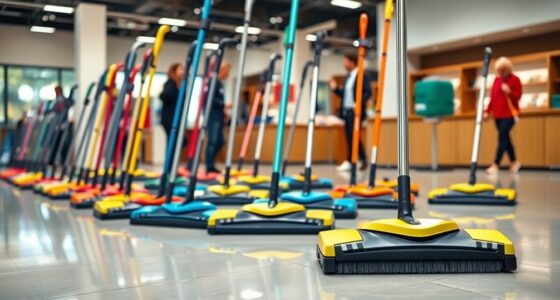For outdoor patios, soft bristle brushes are best for delicate surfaces like glass-topped tables, painted wood, and decorative accents, as they clean fine dust and debris without scratches. Use stiff bristles for tougher tasks such as sweeping leaves, mud, or stubborn dirt from concrete or stone surfaces, but avoid them on fragile furniture. Knowing when to switch between soft and stiff brushes helps keep your patio looking great and damage-free. Keep going to discover more tips on choosing the right tool for each task.
Key Takeaways
- Soft bristle brushes are gentle, ideal for cleaning delicate outdoor furniture and surfaces without scratching.
- Stiff bristle brushes are effective for removing heavy dirt, mud, and debris from hard surfaces like patios and pathways.
- Use soft brushes around plants and painted surfaces to prevent damage during cleaning or pest control.
- Stiff brushes are suitable for tough cleaning tasks but should be avoided on fragile or painted outdoor features.
- The best approach combines both brush types depending on the specific surface and cleaning requirement.

Have you ever wondered how to create a perfect outdoor space for relaxing or entertaining? Your choice of tools and accessories can make all the difference, especially when it comes to maintaining your outdoor patio. One key decision involves selecting the right broom or brush to keep your space clean. When considering garden furniture and keeping pests at bay, the type of bristles—soft versus stiff—can considerably impact your results. Understanding which works best for your needs helps you maintain a tidy, pest-free environment that invites relaxation and enjoyment.
Soft bristle brushes are gentle on delicate surfaces like glass-topped tables, wicker furniture, or painted wood. They’re ideal for sweeping fine debris like dust, pollen, or crumbs without scratching or damaging your furniture or flooring. If you have a lot of intricate garden furniture or decorative accents, soft bristles prevent unnecessary wear and tear, keeping your outdoor space looking fresh and inviting over time. Soft brushes are also helpful for pest control efforts when dealing with areas where pests hide, such as under furniture or around plants. Their gentle touch allows you to sweep away small insects or debris without disturbing the overall surface or causing damage to nearby plants. Additionally, choosing the right cleaning tools can help you perform effective pest management while protecting your surfaces.
Soft bristle brushes gently clean delicate surfaces and prevent damage while helping with pest control around plants and furniture.
Stiff bristle brushes, on the other hand, excel at tackling tougher messes and heavy-duty cleaning tasks. If your patio has rough concrete or stone surfaces, stiff-bristled tools efficiently sweep away stubborn dirt, leaves, or mud. They’re also useful when you need to clear away debris from garden beds or pathways. When pest control is a concern, stiff brushes can be invaluable for dislodging pests hiding within crevices or dense foliage. They help you scrub away nests or egg sacs without harming your garden furniture or plants, especially when used with appropriate pest control products. However, be cautious when using stiff bristles around delicate or painted surfaces, as they can cause scratches or surface damage.
Ultimately, the choice between soft and stiff bristles depends on what you’re cleaning and your outdoor furniture type. A versatile garden tool kit often includes both, allowing you to switch between gentle sweeping for furniture and more aggressive scrubbing for patios and pest-prone areas. Regular maintenance with the right brush helps preserve your garden furniture, reduces pest issues, and keeps your outdoor haven looking its best. Investing in the correct type of bristles ensures that your outdoor space remains comfortable, attractive, and pest-free, so you can enjoy your patio year-round without hassle.
Frequently Asked Questions
Which Bristle Type Is Better for Cleaning Outdoor Furniture?
For cleaning outdoor furniture, stiff bristles are more effective because they provide better cleaning effectiveness, especially on tough dirt and grime. They also tend to have higher bristle durability, so they last longer through repeated scrubbing. Soft bristles might be gentler, but they often struggle with stubborn stains and debris buildup. Choose stiff bristles if you want a thorough clean and a durable brush that withstands regular outdoor use.
How Often Should I Replace Outdoor Patio Brushes?
You should replace your outdoor patio brush every six months, even if it looks fine. Regular cleaning frequency and proper maintenance can extend its lifespan, but over time, bristles wear down and become less effective. Don’t wait until it’s visibly damaged—replace it before cleaning suffers. This ensures your outdoor furniture stays spotless and your cleaning efforts remain efficient. Regular replacement keeps your tools in top shape, saving you time and effort.
Are Softer Bristles More Eco-Friendly Than Stiff Ones?
Yes, softer bristles are generally more eco-friendly because they often have eco friendly benefits, like reducing damage to surfaces and being made from biodegradable options. They break down more easily and cause less environmental harm. When choosing a brush, look for biodegradable options to maximize eco benefits. Softer bristles also require less water and cleaning agents, making them a more sustainable choice for your outdoor patio maintenance.
Can Stiff Bristles Damage Delicate Outdoor Surfaces?
Oh, absolutely—stiff bristles are just itching to cause surface scratches and surface discoloration on your delicate outdoor surfaces. It’s almost like inviting trouble! Using stiff brushes on fragile materials can quickly lead to damage, making your patio look worse for wear. So, unless you want to undo your hard work with unsightly scratches and discoloration, stick with softer brushes that gently clean without harming your beautiful outdoor space.
What Is the Best Storage Method for Patio Cleaning Brushes?
You should store your patio cleaning brushes in a dry, well-ventilated area to prevent mold and bacteria growth. Using wall-mounted hooks or a dedicated storage bin keeps brushes off the ground, protecting their bristles and maintaining their effectiveness. Regular brush maintenance, like cleaning and drying after use, extends their lifespan. Proper storage solutions help keep your brushes in top shape, making your outdoor cleaning routine more efficient and effective.
Conclusion
Choosing between soft and stiff bristles is like picking the right brush for a masterpiece—you want the one that brings your outdoor patio to life without causing damage. Soft bristles gently clean delicate surfaces, while stiff ones tackle stubborn dirt with gusto. Think of your patio as a garden that needs just the right touch to flourish. With the right brush, you’ll keep your outdoor space inviting and pristine, ready for your next outdoor gathering.









